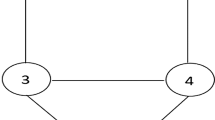Abstract
Lock polynomials and lock tableaux are natural analogues to key polynomials and Kohnert tableaux, respectively. In this paper, we compare lock polynomials to the much-studied key polynomials and give an explicit description of a crystal structure on lock tableaux. Furthermore, we construct an injective, weight-preserving map from lock tableaux to Kohnert tableaux that intertwines with their respective crystal operators. As a result, we see that the crystal structure on lock tableaux has a natural embedding into the Demazure crystal. We also examine the conditions for which key and lock polynomials are symmetric or quasisymmetric.











Similar content being viewed by others
References
Sami Assaf and Nicolle González, Demazure crystals for specialized nonsymmetric Macdonald polynomials, arXiv:1901.07520v2.
H. H. Andersen, Schubert varieties and Demazure’s character formula, Inventiones Mathematicae 79 (1985), 611–618.
Sami Assaf and Anne Schilling, A Demazure crystal construction for Schubert polynomials, Algebraic Combinatorics 1 (2018), no. 2, 225–247.
Sami Assaf and Dominic Searles, Kohnert tableaux and a lifting of quasi-Schur functions, J. Combin. Theory Ser. A 156 (2018), 85–118.
Sami Assaf and Dominic Searles, Kohnert polynomials, Experimental Mathematics (2019).
Daniel Bump and Anne Schilling, Crystal Bases: Representations and Combinatorics, first ed., World Scientific Publishing Company, 2017.
Michel Demazure, Désingularisation des variétés de Schubert généralisées, Ann. Sci. École Norm. Sup. (4) 7 (1974), 53–88, Collection of articles dedicated to Henri Cartan on the occasion of his 70th birthday, I.
Michel Demazure, Une nouvelle formule des caractères, Bull. Sci. Math. (2) 98 (1974), no. 3, 163–172.
Jin Hong and Sook-Jin Kang, Introduction to Quantum Groups and Crystal Bases, Graduate Studies in Mathematics, vol. 42, American Mathematical Society, 2002.
Masaki Kashiwara, On crystal bases of the \(Q\)-analogue of universal enveloping algebras, Duke Math. J. 63 (1991), no. 2, 465–516.
Masaki Kashiwara, The crystal base and Littelmann’s refined Demazure character formula, Duke Math. J. 71 (1993), no. 3, 839–858.
Masaki Kashiwara and Toshiki Nakashima, Crystal graphs for representations of the \(q\)-analogue of classical Lie algebras, J. Algebra 165 (1994), no. 2, 295–345.
Axel Kohnert, Weintrauben, Polynome, Tableaux, Bayreuth. Math. Schr. (1991), no. 38, 1–97, Dissertation, Universität Bayreuth, Bayreuth, 1990.
Peter Littelmann, Crystal graphs and Young tableaux, J. Algebra 175 (1995), no. 1, 65–87.
Alain Lascoux and Marcel-Paul Schützenberger, Keys & Standard Bases, Invariant theory and tableaux (Minneapolis, MN, 1988), IMA Vol. Math. Appl., vol. 19, Springer, New York, 1990, pp. 125–144.
I. G. Macdonald, Symmetric functions and Hall polynomials, second ed., Oxford Mathematical Monographs, The Clarendon Press, Oxford University Press, New York, 1995, With contributions by A. Zelevinsky, Oxford Science Publications.
Sarah Mason, An explicit construction of type A Demazure atoms, J. Combin. Theory Ser. A 23 (2009), 295–313.
Richard P. Stanley, Enumerative Combinatorics. Vol. 2, Cambridge Studies in Advanced Mathematics, vol. 62, Cambridge University Press, Cambridge, 1999, With a foreword by Gian-Carlo Rota and appendix 1 by Sergey Fomin.
Acknowledgements
I am grateful to Sami Assaf for pointing me to this question and for the enlightening (and patient) conversations that followed and to Jim Haglund, Jongwon Kim, and Vasu Tewari for their support. I am also grateful to the referees for improving this paper with their numerous helpful suggestions. The author was partially supported by the NSF Graduate Research Fellowship, DGE-1845298.
Author information
Authors and Affiliations
Corresponding author
Additional information
Publisher's Note
Springer Nature remains neutral with regard to jurisdictional claims in published maps and institutional affiliations.
Supported by NSF DGE-1845298.
Rights and permissions
About this article
Cite this article
Wang, G. Locks Fit into Keys: A Crystal Analysis of Lock Polynomials. Ann. Comb. 24, 767–789 (2020). https://doi.org/10.1007/s00026-020-00513-4
Received:
Accepted:
Published:
Issue Date:
DOI: https://doi.org/10.1007/s00026-020-00513-4




